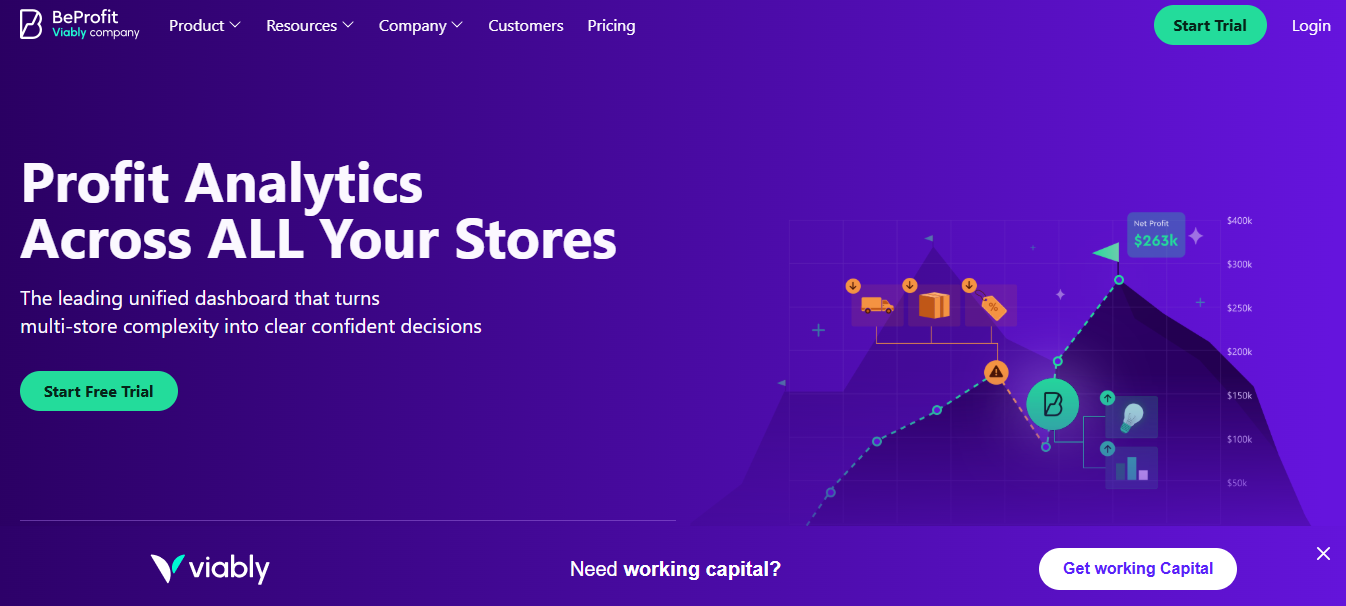Profit is the backbone of every eCommerce business. While revenue grabs attention, it’s your profit margins that determine long-term sustainability. The challenge? Most sellers struggle to see where their money is really going — and that’s exactly where an eCommerce Profit Calculator becomes essential.
That’s where an eCommerce profit calculator comes in. It helps you understand true profitability by factoring in all business expenses, from product sourcing to marketing costs. In this guide, you’ll discover the best eCommerce profit calculator tools and the critical metrics every seller should monitor.
Why You Need an eCommerce Profit Calculator
It’s easy to fall into the trap of assuming your store is thriving just because your revenue looks good. But without accurately calculating profit, you’re making blind decisions. An eCommerce profit calculator gives you clear, data-driven insights into your financial health, helping you:
- Identify which products are actually profitable
- Optimize ad spend and avoid overspending
- Pinpoint hidden costs (like transaction fees or returns)
- Make informed pricing and inventory decisions
- Scale your business based on actual profit, not guesswork
Best eCommerce Profit Calculator Tools (Free & Paid)
Here’s a closer look at the most reliable tools to help you calculate your profits more accurately.
1. BeProfit

BeProfit is one of the most robust and user-friendly profit calculation tools available for eCommerce sellers using platforms like Shopify, WooCommerce, and Amazon.
Key Features:
- Real-time profit tracking based on order data
- Automatically pulls costs from ad accounts (Facebook, Google Ads, TikTok)
- Tracks shipping, taxes, COGS, transaction fees, and returns
- Custom dashboards and visual profit breakdowns
- Supports multiple stores and currencies
Why it’s useful:
BeProfit gives you a real-time picture of how each product and campaign affects your bottom line. It’s ideal for sellers running ads and scaling fast. With detailed profit per order and channel, you get actionable data without crunching numbers manually.
2. TrueProfit

TrueProfit is built specifically for fast-moving eCommerce businesses that want automated, real-time financial data.
Key Features:
- Order-level profit calculation
- Integration with Shopify, Amazon, and major ad platforms
- Auto-syncs product costs, shipping, and discounts
- Calculates gross profit, net profit, and ROI instantly
- Mobile app for tracking profit on-the-go
Why it’s useful:
TrueProfit is designed for sellers who want to see profit margins as sales happen. It simplifies complex tracking and helps you quickly spot what’s hurting or helping your profitability—especially across ad channels.
3. Shopify Profit Calculator

This free online tool by Shopify is ideal for beginners and solo entrepreneurs.
Key Features:
- Input product cost, price, shipping, and marketing fees
- Instant calculation of profit per unit and margin
- Simple, clean interface
Why it’s useful:
It’s a great starting point if you’re new to eCommerce and want to test different pricing and cost scenarios. While it lacks automation, it’s perfect for basic profit projections.
4. Shopkeeper

Shopkeeper is a powerful, automated eCommerce profit calculator built specifically for Amazon sellers. Unlike manual spreadsheets, it pulls real-time data directly from your Amazon account and presents everything in a beautifully simple dashboard.
Key Features:
- Tracks net profit per product, per day, and per marketplace
- Includes all Amazon fees: FBA, storage, referral, refund costs, etc.
- Real-time dashboard with clean visuals and easy-to-read summaries
- Inventory forecasting and alert system to prevent stockouts
- Supports international sellers with multiple currency support
Why it’s useful:
Shopkeeper goes beyond basic profit calculation by providing a full financial snapshot of your Amazon business. Whether you’re selling in one country or globally, it gives you clarity on which products are truly profitable and alerts you to rising costs, fees, and low inventory. It’s ideal for Amazon sellers who need speed, precision, and zero spreadsheet hassle.
5. QuickBooks Commerce

QuickBooks Commerce is a robust accounting and inventory management platform that also offers in-depth profit analysis.
Key Features:
- Real-time profit and loss tracking
- Advanced inventory and order management
- Tracks expenses like software, rent, payroll
- Syncs with major eCommerce platforms
- Generates P&L statements, cash flow reports, and more
Why it’s useful:
QuickBooks is ideal for growing brands that want a complete financial overview, not just profit per product. It’s excellent for eCommerce businesses transitioning into a more structured operation.
Key Metrics to Track Using an eCommerce Profit Calculator
Your profit calculator is only as useful as the data you feed it. These are the essential metrics that give you a full picture of your financial performance:
1. Cost of Goods Sold (COGS)
COGS includes all the direct costs involved in producing or purchasing your products. This may include:
- Manufacturing or supplier costs
- Packaging and labeling
- Freight, import taxes, and duties
Why it matters:
COGS directly affects your gross profit. If you underestimate COGS, your profit margins will appear better than they are—leading to poor decisions on pricing or ad spend.
2. Gross Profit Margin
Formula:
(Revenue – COGS) / Revenue × 100
This shows how much you make before operating expenses.
Why it matters:
It tells you whether your product pricing is sustainable. A low margin might mean it’s time to raise prices, reduce COGS, or stop promoting certain items.
3. Net Profit Margin
Formula:
(Net Profit / Total Revenue) × 100
Net profit margin includes all expenses: marketing, tools, platform fees, shipping, and even payroll.
Why it matters:
This is the true measure of profitability. It reflects your operational efficiency and is crucial for long-term success.
4. Customer Acquisition Cost (CAC)
Formula:
Total Marketing Spend / Number of New Customers Acquired
Why it matters:
If your CAC is too high compared to your profit per order, you’re essentially buying customers at a loss. Knowing this helps optimize your marketing strategy.
5. Average Order Value (AOV)
Formula:
Total Revenue / Total Number of Orders
Why it matters:
Higher AOV = higher profit potential per transaction. Combine this with upselling, bundling, or discounts to drive more profit from every sale.
6. Return Rate and Refund Costs
Returns aren’t just an inconvenience—they’re a direct hit to your profits. High return rates often indicate issues with product quality, shipping delays, or customer expectations.
Why it matters:
A good eCommerce profit calculator should factor in refund-related losses, especially for fashion, electronics, and high-ticket items where return rates are common.
7. Fees and Platform Deductions
These often-overlooked costs include:
- Shopify or WooCommerce subscription fees
- Payment processor fees (Stripe, PayPal, etc.)
- Third-party app/tool costs
- Marketplace commissions (Amazon, Etsy)
Why it matters:
Neglecting these fees leads to inflated profit numbers. A great calculator should track these automatically or allow manual input for accuracy.
Final Thoughts
A powerful eCommerce profit calculator is a must-have tool—not just for accountants, but for any serious seller who wants to grow sustainably. When paired with tracking the right metrics, it transforms how you see your business.
Start simple if needed (Shopify’s calculator or a Google Sheet), then graduate to tools like BeProfit or QuickBooks as your store grows. The sooner you start analyzing profit instead of guessing, the sooner you’ll make decisions that actually move the needle.
Quick Comparison Table
| Tool | Platforms Supported | Key Features | Pricing | Best For |
|---|---|---|---|---|
| BeProfit | Shopify, WooCommerce, Amazon | Real-time profit tracking, ad spend sync, visual dashboards, multi-store | Free plan + Paid | Growing businesses needing deep analytics |
| TrueProfit | Shopify, Amazon | Auto-sync product costs, live order-level profit, mobile app | Paid plans only | Scaling stores & ad-heavy businesses |
| Shopify Calculator | Web-based (Any platform) | Manual entry, basic profit & margin output | Free | Beginners & quick estimations |
| Shopkeeper | Amazon (all marketplaces) | Auto-imports all fees, real-time profit tracking, inventory forecasting | Paid plans | Amazon sellers needing detailed insights |
| QuickBooks Commerce | Shopify, Amazon, Etsy, etc. | P&L reports, accounting features, inventory management, financial tracking | Paid (subscription) | Larger businesses needing accounting + profit |
Choosing the Right eCommerce Profit Calculator Tool
-
BeProfit and TrueProfit are ideal for Shopify, WooCommerce, and multi-channel sellers looking for automated profit tracking across products, ads, and orders.
-
Shopkeeper is the best choice for Amazon sellers, offering real-time analytics with built-in tracking of all Amazon-related fees and inventory forecasting.
-
Shopify’s Profit Calculator is a basic tool meant for quick, one-time calculations—great for beginners testing pricing strategies.
-
QuickBooks Commerce is suited for established businesses that require full accounting and inventory features alongside profit tracking.
-
Consider your platform, business stage, and data complexity before choosing a tool. Automation saves time, but spreadsheets or simple calculators can work if you’re just starting out.
✅ Want to scale smarter and stay profitable?
Want more expert tips, tool reviews, and growth strategies for your online store? Explore all our insights at eCommerce Suggestions.




